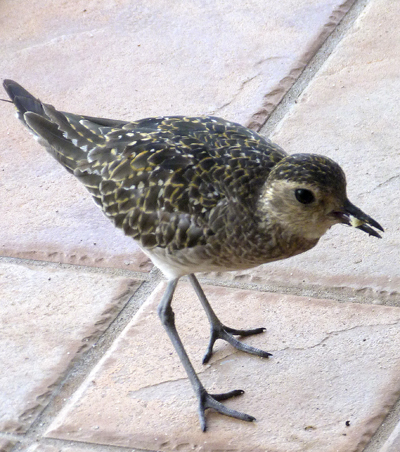Published in the Ocean Watch column, Honolulu Star-Advertiser © Susan Scott
October 21 2013
We Hawaii residents love our kolea, the migratory shorebirds that nest in Alaska in summer and spend winters in the islands.
I use the terms summer and winter loosely because the birds, also called Pacific golden plovers, straddle the seasons, spending only about three months in Alaska. The birds leave Hawaii on or around April 25, usually all heading north within a day or two, and begin returning in early August.
It takes about three nonstop days for the birds to reach their Alaska breeding grounds and nearly four days (against the wind) to get back to Hawaii.
Gracie the Pacific golden plover makes an appearance on Susan Scott’s lanai.
The birds, called kolea in Hawaiian, winter in the isles.
©2013 Susan Scott
First come the females — pooped, I imagine, from laying four eggs and then chasing after foraging chicks to protect them from Arctic predators such as foxes and jaegers. Males arrive next. Newly fledged juveniles get here last, some as late as October.
Here in Hawaii we sometimes see kolea in the early summer months because if they’re underweight or injured, they can’t make the 3,000-mile nonstop trip over the North Pacific, and therefore sit out the breeding season. Healthy, well-nourished birds (weight: 3 to 4 ounces) make the round-trip flight each year.
The reason we islanders know plovers so well is that individuals return to the same wintering spot year after year. If you have a plover in your yard, get used to it. Kolea have a life span of at least 26 years. My plover, a female I call Gracie after her ballerinalike bearing, showed up a year ago on my lawn, where I tossed her chunks of scrambled egg. She ate so eagerly that I microwaved an egg just for her, keeping it in the fridge to dole out in tiny pieces when she came around. Soon Gracie was prancing onto our tiled lanai, charming my friends and family with her elegant appeal for food, which she received in abundance. Gracie left in April, all plump and golden.
When I got home from Tahiti late last month, there was Gracie touching her beak adorably on my screen door, as if to say, “Got eggs?” For this bold beauty who even allows my gentle old dog to sniff her through the screen, boy, do I have eggs.
To learn more about our Pacific golden plovers, come to Windward Community College tonight at 7, where kolea expert Wally Johnson is giving a free talk and slide show called “Kolea Biology Update, 2013: They Continue to Amaze Us.” This Hawaii Audubon Society and Windward Community College event is open to the public in Room 103 of Hale ‘Akoakoa.
I wouldn’t miss it for the world. See you there.
